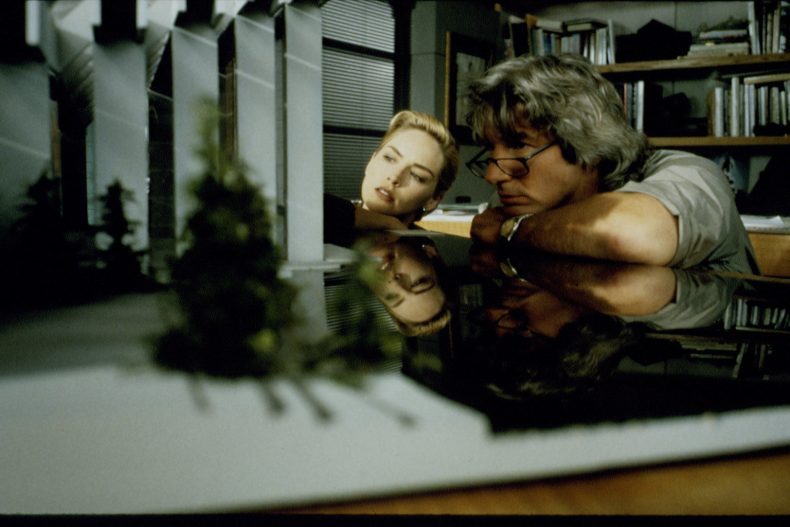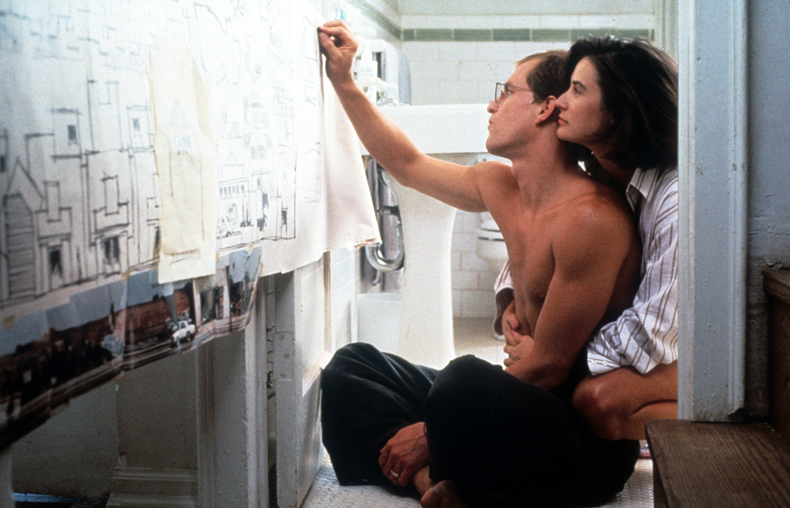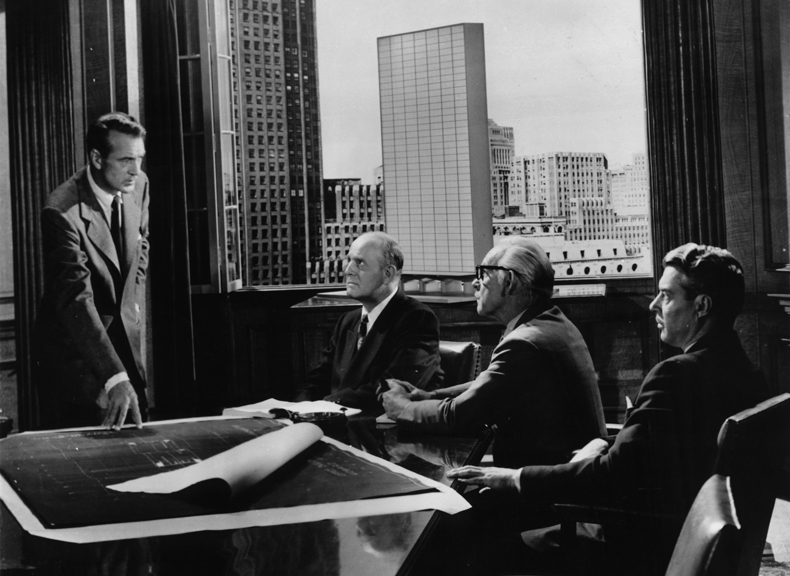From the June 2024 issue of Apollo. Preview and subscribe here.
In The Fountainhead (1949), King Vidor’s cinematic adaptation of Ayn Rand’s bestselling novel, Gary Cooper plays Howard Roark, an uncompromising architect battling against the forces of mediocrity. Cooper is perfect as Roark, a brooding figure of few words but an iron will. Contrasted with slippery careerists, conniving critics and others who would enslave the human spirit, Roark is presented as a figure of almost supernatural purity.
Vidor’s film is largely faithful to Rand’s book and world view, repeating chunks of its convoluted dialogue arguing for the importance of the individual over the state and for unfettered creative freedom over collective responsibility. But, despite being the epitome of Rand’s personal brand of right-wing ideology, Roark is also an unapologetic modernist. His architecture – part Frank Lloyd Wright, part Richard Neutra – is contrasted with weak Beaux Arts eclecticism and fag-end classicism, both styles deemed by Rand to be ‘un-American’.
Cooper’s portrayal is of the architect as a lone gun: he has no staff, and he doesn’t work with engineers or any other consultants. In this unrealistic representation of the architect’s working life, Roark is not unusual. The individual architect, armed only with a set square and pencil, working away on some grand scheme that has no obvious deadline, client or contact with reality is a persistent cinematic myth.
In Ben Wheatley’s adaptation of the J.G. Ballard novel High-Rise (2015), the building’s architect, Anthony Royal, is played with elegiac campness by Jeremy Irons as another remote figure, alone in his penthouse, forever refining his design while his dream literally collapses around him. It is also the architect as played by Pierce Brosnan in the 2008 film Mamma Mia! (who mostly stands at his board drawing an unspecified something when not murdering ABBA songs) or Liam Neeson in Love Actually (2003), whose unconvincing attempts to do some work are forever interrupted by the film’s mawkish storyline.

Building a happy marriage: Sharon Stone and Richard Gere as the husband-and-wife executives of an architecture firm in Intersection (1994), directed by Mark Rydell. Photo: Frank Trapper/Corbis via Getty Images
Sometimes architects represent a kind of unthreatening, middle-class decency, but they can also be depicted as remote aesthetes with a fetish for concrete and suits with no collars. Often, they appear as romantic figures, unworldly but well-intentioned dreamers or as rugged, practical types forever pointing at holes in the ground while wearing a hard hat. That is when they are not being satirised as crazed egomaniacs with a desire to subjugate the rest of us with their oppressive visions of the future.
The characters mentioned so far have something specific in common: they are all men. Women architects on film are predictably far and few between. In One Fine Day (1996), Michelle Pfeiffer’s character is presented as a single mother first and an architect second, struggling to keep career and kids on track. She does at least work in an actual office, at one point dropping a model after tripping up on the way through a revolving door. But One Fine Day is a rom-com, more interested in mining laughs about juggling parenthood and corporate life than in architecture.
There are more slick clothes and even slicker offices on show in Intersection (1994), starring Richard Gere as architect Vincent Eastman. We first meet Eastman sitting half naked and staring at a model of his latest house design. When his girlfriend attempts to coax him back to bed, Eastman declines, pointing mournfully at the model and mumbling something about fenestration. So here we are, back with the architect as moody, male genius and women as merely his enablers.
Another strand of the mythical cinematic architect is that of the loser: the architect as a dreamy idealist crushed by the realities of life. Arguably, there is no bigger cinematic loser than the character played by Woody Harrelson in Indecent Proposal (1993). Not only does Woody’s wife – played by Demi Moore – decide to sleep with oily businessman Robert Redford for cash, but his practice folds and the bank forecloses on their house.

Solid foundations? Woody Harrelson and Demi Moore play an architect and his estate-agent wife in Indecent Proposal (1993), directed by Adrian Lyne. Photo: Paramount Pictures/Getty Images
In a series of excruciating voiceovers, Harrelson describes his and Demi’s cash-strapped honeymoon/study tour visiting his favourite buildings. He keeps a model of his ideal house – early Frank Gehry meets Morphosis – under the bed, the ever-present threat of an impromptu critical review surely offering the most likely reason for the break-up of his marriage.
Left penniless, Harrelson goes back to teaching, where his vapid idealism proves a huge hit. Brandishing a brick and repeating Louis Kahn’s pseudo-mystical mantra about the brick’s destiny as architecture, the camera pans across the rapt faces of his students to unintentionally hilarious effect.
Richard Linklater’s overlooked film Where’d You Go, Bernadette (2019) returns us to the architect as singular genius. But this time the architect is played by Cate Blanchett as a spiky and anti-social woman reassessing her life after 15 years of motherhood. In a clunky piece of exposition, we see Blanchett watching a documentary about her stellar early career while a narrator praises her pioneering green design and brilliant manipulation of light and space. A former supporter, played by Laurence Fishburne, begs her to come back. But to what? The laborious realities of building a career, managing an office or schmoozing a client base are ignored in favour of a far more dependable cinematic trope: the wayward hero making it back from the wilderness. That this is mixed with a more contemporary theme concerning the career sacrifices of parenthood makes the architectural aspects of the plot no less ridiculous. In fact, Blanchett’s Bernadette Fox is in many ways a modern version of Howard Roark, a self-destructive genius and an artist who must be free to create whatever the cost. Despite the gender shift, we have not perhaps come very far.
All of which begs the question: who or what is the architect? And what does their cinematic representation tell us about their role and status? That architects are noble but inflexible dreamers? Or petulant nihilists? Megalomaniac utopians? Incompetent businessfolk? Innocent dupes? Or all of these? The cinematic portrayal of the architect only serves to compound an existing identity crisis. Almost any fictional representation of the architectural profession veers towards the ridiculous. But that doesn’t mean that they might not contain some elements of truth. As Laurence Fishburne’s character puts in Linklater’s film, ‘Bernadette stands out because no one knows exactly who she is.’

Gary Cooper as the architect Howard Roark, presenting a blueprint in The Fountainhead (1949), directed by King Vidor. Photo: Warner Brothers/Getty Images
From the June 2024 issue of Apollo. Preview and subscribe here.














![Masterpiece [Re]discovery 2022. Photo: Ben Fisher Photography, courtesy of Masterpiece London](http://zephr.apollo-magazine.com/wp-content/uploads/2022/07/MPL2022_4263.jpg)
‘Like landscape, his objects seem to breathe’: Gordon Baldwin (1932–2025)